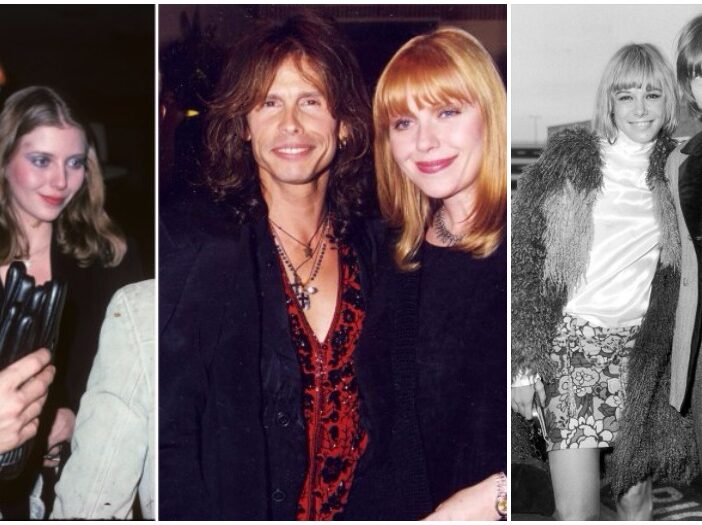
3. LINDSEY BUCKINGHAM, STEVIE NICKS, MICK FLEETWOOD

Fleetwood Mac drummer Mick Fleetwood invited a talented young guitarist named Lindsey Buckingham to join the band in late 1974. But Buckingham had one stipulation: his longtime girlfriend and musical collaborator, Stevie Nicks, had to come too. The new partnership was certainly a commercial triumph, leading to the smash success of their 1975 self-titled album, but the personal relationships within the band began to crumble. Buckingham and Nicks split up by 1976, as did bassist John McVie and his wife, keyboardist Christine McVie. Fleetwood had it comparatively easy by not being romantically entwined with anyone in the band, but his own marriage to Jenny Boyd (sister of Pattie, another entry on this list) was foundering.
In the midst of this personal turmoil—and a blizzard of cocaine—Fleetwood Mac recorded their 1977 blockbuster, Rumours. The thinly disguised references to their romantic tribulations turned the album into something of a musical soap opera, and it became one of the highest selling records of the decade. As the band hit the road to promote Rumours, Fleetwood and Nicks began a furtive affair. “Never in a million years could you have told me that would happen,” Nicks later told Uncut magazine. “Everybody was angry because Mick was married to a wonderful girl and had two wonderful children. I was horrified. I loved these people. I loved his family. So it couldn’t possibly work out. And it didn’t. I just couldn’t.” Inevitably, their romance was doomed from the start. Fearing that it “would have been the end of Fleetwood Mac” if they continued, the pair agreed to stop seeing each other. Fleetwood eventually began a relationship with Nicks’ best friend, Sara Recor, whom he married in 1988.
3. DAVID CROSBY, JONI MITCHELL, GRAHAM NASH

Perhaps the least dramatic love triangle on this list belongs to these icons of the late ’60s singer/songwriter scene. David Crosbyfirst encountered the Canadian chanteuse in a Florida coffee house not long after he was forced out of his group, the Byrds, in the summer of 1967. “She was standing there singing all those songs: ‘Michael From Mountains,’ ‘Both Sides Now,’ and I was just floored. I couldn’t believe that there was anybody that good,” he later remembered. Enchanted by her voice, Crosby persuaded Mitchell to accompany him back to his native Los Angeles, where he introduced her to his record industry contacts—including future mogul David Geffen—and helped secure her a record contract. Crosby even acted as producer on her 1968 debut, Song to a Seagull.
Crosby’s attraction to Mitchell was more than just musical, and he soon fell in love with the beautiful and supremely talented singer. They spent a spell living together after she moved out to California, and his ballad “Guinnevere” was partially inspired by her (“It might be my best song,” he told Rolling Stone in 2008). “It was very easy to love her, but turbulent,” he remembered. “Loving Joni is a little like falling into a cement mixer.” According to Mitchell herself, they were “never an item,” apart from a short affair soon after meeting in Florida.
Though the memories differ, it’s widely agreed that Crosby first sang with his future bandmates Stephen Stills and Graham Nash while visiting Mitchell’s Laurel Canyon home in late 1968. Nash had met Mitchell the previous year when his band, the Hollies, were playing a show. Like Crosby before him, Nash was smitten. “She was the whole package,” he would later write in his memoir, “a lovely, sylphlike woman with a natural blush …and an elusive quality that seemed lit from within.” After leaving the Hollies, Nash accepted Mitchell’s invitation to live with her in the small cottage on leafy Lookout Mountain Avenue. He would later write the song “Our House” about his time there, aglow with love and domestic bliss. She would counter with the song “Willy,” her nickname for Nash.
Their relationship coalesced around the same time as the burgeoning supergroup, Crosby, Stills and Nash. Despite the emotional complications, Nash insisted that Crosby bore him no ill will for dating Mitchell. “They were lovers,” Nash later said, “[But] it was nothing to me and David that I would go live with Joan. It was all right all the way around.”
Ultimately, his musical partnership with Crosby would last longer than his romance with Mitchell. They split around the time she released her 1971 album, Blue. Widely hailed as her masterpiece, Nash finds listening to it”difficult for me personally. It brings back many memories and saddens me greatly. It is, by far, my most favorite solo album, and the thought that I spent much time with this fine woman and genius of a writer is incredible to me. I watched her write some of those songs and I believe that one or two of them were about me, but who really knows?”
